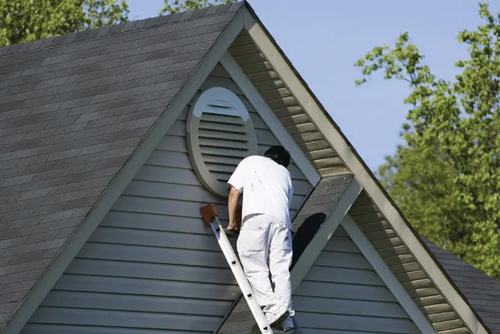If you’re a homeowner looking to refresh the exterior of your house, one of the questions you might have is, “When is the best time to paint the exterior?” While painting can be done throughout the year, each season comes with its own set of advantages and challenges. In this blog, we’ll explore the pros and cons of each season for exterior painting to help you make an informed decision.
Spring: Embrace the Mild Temperatures
As winter makes way for spring, the milder temperatures make this season a favorable time for exterior painting in many regions. With comfortable weather conditions, painters can work more efficiently and comfortably. Additionally, paints tend to dry optimally at moderate temperatures, promoting better adhesion to the surfaces and creating a durable finish.
One significant advantage of painting in spring is the relatively lower humidity levels compared to the hot summer months. Lower humidity prevents issues like blistering and bubbling, ensuring a smooth and even application of the paint. However, it’s essential to keep a close eye on the weather forecast during the spring, as unexpected rain showers can interrupt the painting process and compromise the quality of the paint job.
Summer: High Temperatures, High Caution
The long days and predictable weather of summer often make it a popular season for exterior painting projects. However, painting during the summer months requires careful planning and precautions due to the high temperatures that come with this season.
Extreme heat can pose challenges during painting, as it accelerates the drying process of the paint. Rapid drying can lead to issues such as lap marks, uneven application, and adhesion problems. To overcome this, professional painters typically schedule their work during the early morning or late afternoon when the temperatures are more moderate.
Furthermore, humidity levels must be considered during the summer. High humidity can extend the drying time of the paint, making it more susceptible to collecting dust, dirt, and debris. Therefore, it is essential to monitor humidity levels and take appropriate measures to ensure the best possible outcome for your exterior painting project during the summer season.
Fall: Ideal Conditions for Exterior Painting
Many painting experts and professionals argue that fall might be the best season for exterior painting, and for several good reasons. As the temperatures start to cool down from the scorching summer, painting in the fall offers an optimal balance of mild weather conditions.
With cooler temperatures, the risk of the paint drying too quickly decreases, allowing for a more controlled and even application. Additionally, the lower humidity levels in the fall contribute to efficient drying and curing of the paint. Less moisture in the air reduces the chances of issues like blistering and peeling, providing a smoother and more durable finish.
Furthermore, the fall season often experiences less rainfall, providing ample opportunities for exterior painting projects. Ensuring that the paint is not exposed to rain during
Winter: Challenging but Not Impossible
Winter is generally considered the least favorable season for exterior painting, and for good reason. The cold temperatures can cause the paint to freeze, preventing it from drying correctly and leading to adhesion issues. Most paints require temperatures above 50°F (10°C) for proper application and curing, making winter painting challenging in colder regions.
If you must undertake an exterior painting project during the winter months, it’s crucial to choose a day when temperatures are milder and more suitable for painting. Plan for shorter daylight hours and be prepared to take extra precautions to ensure the paint dries and cures effectively. Additionally, it’s essential to use paint products specifically formulated for colder temperatures and follow the manufacturer’s guidelines closely.
In regions with milder winters, where temperatures stay consistently above the minimum requirements, exterior painting can still be manageable. However, it’s advisable to consult with professional painters who have experience working in colder climates and can offer valuable insights and techniques to achieve a successful paint job.
Contact Revel Painting for Professional Exterior Painting
The best season for exterior painting depends on your specific climate and weather conditions. Spring and fall are generally the most favorable seasons, offering mild temperatures and lower humidity levels that facilitate proper paint adhesion and drying. Summer can also be an option, but painters need to be cautious about extreme heat. Winter painting is challenging and should be approached with extra care.
Remember, when it comes to exterior painting, preparation is key regardless of the season. Properly cleaning, repairing, and priming the surfaces will contribute significantly to the longevity and overall quality of the paint job.
Consult with a professional painting contractor who can assess your specific needs and guide you on the best season for your exterior painting project. With the right timing and execution, your home can look fresh, vibrant, and well-protected against the elements. Give Revel Painting a call today at 612-345-9136 and our team will help you decide on the best time to paint your home’s exterior.



